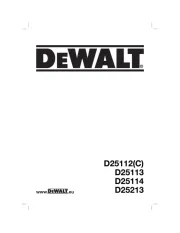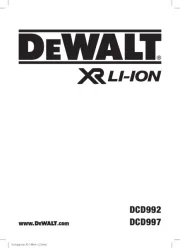Minimum Gage for Cord Sets
Volts Total Length of Cord in Feet
120V 0-25 26-50 51-100 101-150
240V 0-50 51-100 101-200 201-300
Ampere Rating
More Not more AWG
Than Than
6 - 10 18 16 14 12
10 - 12 16 16 14 12
•OUTDOOR USE EXTENSION CORDS. When tool is used outdoors, use only extension
cords intended for use outdoors and so marked.
•STAY ALERT. Watch what you are doing. Use common sense. Do not operate tool when you
are tired.
•CHECK DAMAGED PARTS. Before further use of the tool, a guard or other part that is dam-
aged should be carefully checked to determine that it will operate properly and perform its
intended function. Check for alignment of moving parts, binding of moving parts, breakage
of parts, mounting, and any other conditions that may affect its operation. A guard or other
part that is damaged should be properly repaired or replaced by an authorized service cen-
ter unless otherwise indicated elsewhere in this instruction manual. Have defective switches
replaced by authorized service center. Do not use tool if switch does not turn it on and off.
CAUTION: Wear appropriate personal hearing protection during use. Under some con-
ditions and duration of use, noise from this product may contribute to hearing loss.
CAUTION: When drilling or driving into walls, floors or wherever live electrical wires may be
encountered, DO NOT TOUCH ANY METAL PARTS OF THE TOOL! Hold the tool only by insu-
lated grasping surfaces to prevent electric shock if you drill or drive into a live wire.
WARNING: Some dust created by power sanding, sawing, grinding, drilling, and other con-
struction activities contains chemicals known to cause cancer, birth defects or other reproduc-
tive harm. Some examples of these chemicals are:
• lead from lead-based paints,
• crystalline silica from bricks and cement and other masonry products, and
• arsenic and chromium from chemically-treated lumber (CCA).
Your risk from these exposures varies, depending on how often you do this type of work. To
reduce your exposure to these chemicals: work in a well ventilated area, and work with
approved safety equipment, such as those dust masks that are specially designed to filter out
microscopic particles.
•Avoid prolonged contact with dust from power sanding, sawing, grinding, drilling, and
other construction activities. Wear protective clothing and wash exposed areas with
soap and water. Allowing dust to get into your mouth, eyes, or lay on the skin may promote
absorption of harmful chemicals.
WARNING: Use of this tool can generate and/or disburse dust, which may cause serious and
permanent respiratory or other injury. Always use NIOSH/OSHA approved respiratory protection
appropriate for the dust exposure. Direct particles away from face and body.
• The label on your tool may include the following symbols.
V................volts A ..................amperes
Hz..............hertz W..................watts
min ............minutes ................alternating current
..........direct current no ................no load speed
..............Class II Construction …/min ..........revolutions or reciprocation per minute
..............earthing terminal ................safety alert symbol
Grounding Instructions
This tool should be grounded while in use to protect the operator from electric shock. The tool
is equipped with a 3-conductor cord and 3-prong grounding type plug to fit the proper ground-
ing type receptacle. The green (or green and yellow) conductor in the cord is the grounding wire.
Never connect the green (or green and yellow) wire to a live terminal. If your unit is intended for
use on less than 150 V, it has a plug that looks like that shown in sketch A. If it is for use on 150
to 250 V, it has a plug that looks like that shown in sketch D. An adapter, sketches B and C, is
available for connecting sketch A type plugs to 2-prong receptacles. The green-colored rigid ear,
lug, or the like, extending from the adapter must be connected to a permanent ground, such as
a properly grounded outlet box. No adapter is available for a plug as shown in sketch D.
ADAPTER SHOWN IN FIGURES B and C IS NOT FOR USE IN CANADA.
SAVE THESE INSTRUCTIONS
Motor
Your DEWALT tool is powered by a D WALT built motor. Be sure your power supply agrees withE
the nameplate marking. The markings; 120 volts, 50/60 Hz or “AC/DC”, mean that your drill will
operate on alternating or direct current.Voltage decrease of more than 10% will cause loss of
power and overheating. All DEWALT tools are factory tested; if this tool does not operate, check
the power supply.
Side Handle
To install the side handle, use the metal plate, four screws and four lock washers included with
the unit. Install the plate with the screws as shown in Figure 1. Tighten all screws securely.
Screw the threaded end of the side handle into the plate and tighten securely.
CAUTION: Always use and hold firmly the side handle or spade handle. This is a high-torque
drill: always hold it with both hands when operating. The side handle screws into the large hole
in the top of the tool.
Switch
To turn the tool ON, depress the trigger switch. To turn the tool OFF, release the trigger switch.
(See Figure 2).
The toggle switch above the trigger is the
reversing switch
. Switch this toggle only when the
tool is not running or coasting. After reversing operations are completed, switch the toggle back
to forward position.
To lock the tool ON, depress the trigger and push in the
lock button
. Then, while holding the
lock button in position, gently release the trigger. To release locking mechanism, depress trig-
ger fully, then release it. Do not lock the switch ON when drilling by hand so that you can instant-
ly release the trigger switch if the bit binds in the hole. The locking feature is for use when the
drill is mounted in a drill stand or otherwise firmly held. THE LOCKING FEATURE IS NOT FOR
USE WHEN DRILLING BY HAND. Be sure to release the switch lock button before discon-
necting the tool from the power supply. Failure to do so will cause the tool to start immediately
the next time it is plugged in. Damage or injury could result.
For reversing operation, turn the tool off and wait for it to stop coasting. Grasp the reversing ring
(Fig. 3) and turn it counterclockwise until the raised indicator aligns with the word REVERSE.
Chuck
To insert bit,
open chuck jaws by turning collar with fingers and insert shank of bit about 3/4"
(19mm) into chuck. Tighten chuck collar by hand. Place chuck key in each of the three holes
and tighten in clockwise direction. It’s important to tighten chuck with all three holes.
To release
bit
, turn chuck key counterclockwise in just one hole, then loosen the chuck by hand.
Chuck Removal
1. turn off tool and DISCONNECT FROM POWER SUPPLY.
2. Place chuck key in chuck.
A B C
GROUNDING PIN
GROUNDED
OUTLET
BOX GROUNDING
MEANS
ADAPTER GROUNDING PIN
D
INSTRUCTION MANUAL
GUIDE D'UTILISATION
MANUAL DE INSTRUCCIONES
INSTRUCTIVO DE OPERACIÓN, CENTROS DE SERVICIO Y PÓLIZA
DE GARANTÍA. LÉASE ESTE INSTRUCTIVOADVERTENCIA:
ANTES DE USAR EL PRODUCTO.
DEWALT Industrial Tool Co., 701 East Joppa Road, Baltimore, MD 21286
(OCT05) Form No. 637575-00 DW138, DW138-220, DW139
Copyright © 1998, 2002, 2003, 2005 DEWALT
The following are trademarks for one or more DEWALT power tools: the yellow and black color scheme; the
“D” shaped air intake grill; the array of pyramids on the handgrip; the kit box configuration; and the array of
lozenge-shaped humps on the surface of the tool.
DW138, DW138-220, DW139
3/4" and 5/8" (13mm and 17mm) Spade Handle Drills
Perceuses de 13 mm et 17mm (3/4 et 5/8 po) à poignée-bêche
Taladros 13 mm y 17mm (3/4 "y 5/8") Mango tipo espada
If you have questions or comments, contact us.
Pour toute question ou tout commentaire, nous contacter.
Si tiene dudas o comentarios, contáctenos.
1-800-4-DEWALT • www.dewalt.com
IF YOU HAVE ANY QUESTIONS OR COMMENTS ABOUT THIS OR ANY DEWALT TOOL,
CALL US TOLL FREE AT: 1-800-4-DEWALT (1-800-433-9258)
Important Safety Instructions
WARNING: When using electric tools, basic safety precautions should always be followed
to reduce risk of fire, electric shock, and personal injury, including the following:
READ ALL INSTRUCTIONS
Safety Instructions For All Tools
•KEEP WORK AREA CLEAN. Cluttered areas and benches invite injuries.
•CONSIDER WORK AREA ENVIRONMENT. Don’t expose power tools to rain. Don’t use
power tools in damp or wet locations. Keep work area well lit. Do not use tool in presence of
flammable liquids or gases.
•GUARD AGAINST ELECTRIC SHOCK. Prevent body contact with grounded surfaces. For
example; pipes, radiators, ranges, and refrigerator enclosures.
•KEEP CHILDREN AWAY. Do not let visitors contact tool or extension cord. All visitors should
be kept away from work area.
•STORE IDLE TOOLS. When not in use, tools should be stored in dry, and high or locked-up
place — out of reach of children.
•DON’T FORCE TOOL. It will do the job better and safer at the rate for which it was intended.
•USE RIGHT TOOL. Don’t force small tool or attachment to do the job of a heavy-duty tool.
Don’t use tool for purpose not intended.
•DRESS PROPERLY. Do not wear loose clothing or jewelry. They can be caught in moving
parts. Rubber gloves and non-skid footwear are recommended when working outdoors. Wear
protective hair covering to contain long hair. Air vents often cover moving parts and should
also be avoided.
•USE SAFETY GLASSES. Also use face or dust mask if operation is dusty.
•DON’T ABUSE CORD. Never carry tool by cord or yank it to disconnect from receptacle.
Keep cord from heat, oil, and sharp edges.
•SECURE WORK. Use clamps or a vise to hold work. It’s safer than using your hand and it
frees both hands to operate tool.
•DON’T OVERREACH. Keep proper footing and balance at all times.
•MAINTAIN TOOLS WITH CARE. Keep tools sharp and clean for better and safer perfor-
mance. Follow instructions for lubricating and changing accessories. Inspect tool cords peri-
odically and if damaged, have repaired by authorized service facility. Inspect extension cords
periodically and replace if damaged. Keep handles dry, clean, and free from oil and grease.
•DISCONNECT OR LOCK OFF TOOLS when not in use, before servicing, and when chang-
ing accessories, such as blades, bits, cutters.
•REMOVE ADJUSTING KEYS AND WRENCHES. Form habit of checking to see that keys
and adjusting wrenches are removed from tool before turning it on.
•AVOID UNINTENTIONAL STARTING. Don’t carry tool with finger on switch. Be sure switch
is off when plugging in.
•EXTENSION CORDS. Use only 3-wire extension cords that have 3-prong grounding-type
plugs and 3-pole receptacles that accept the tool’s plug. Replace or repair damaged cords.
Make sure your extension cord is in good condition. When using an extension cord, be sure
to use one heavy enough to carry the current your product will draw. An undersized cord will
cause a drop in line voltage resulting in loss of power and overheating. The following table
shows the correct size to use depending on cord length and nameplate ampere rating. If in
doubt, use the next heavier gage. The smaller the gage number, the heavier the cord.




















